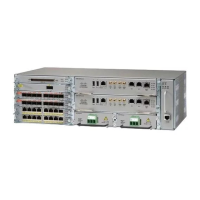Site Cabling Guidelines
This section contains guidelines for wiring and cabling at your site. When preparing your site for network
connections to the Cisco ASR 903 Router, consider the type of cable required for each component, and the
cable limitations. Consider the distance limitations for signaling, electromagnetic interference (EMI), and
connector compatibility. Possible cable types are fiber, thick or thin coaxial, foil twisted-pair, or unshielded
twisted-pair cabling.
Also consider any additional interface equipment you need, such as transceivers, hubs, switches, modems,
channel service units (CSU), or data service units (DSU).
Before you begin, read these important notes about cabling:
•
The T1/E1 interface module for the Cisco ASR 903 Router uses a high-density connector that requires
the use of a T1/E1 interface cable and a customer-provided patch panel. For more information,
seeConnecting T1/E1 cables.
•
Shielded cables must be used to connect to the RS-48 alarm connector on the fan tray in order to comply
with FCC/EN55022/CISPR22 Class A emissions requirements. For information about the fan tray alarm
port, see Connecting the Fan Tray Alarm Port.
Before you install the Cisco ASR 903 Router, have all the additional external equipment and cables on hand.
For information about ordering, contact a Cisco customer service representative.
The extent of your network and the distances between the network interface connections depend in part on
the following factors:
•
Signal type
•
Signal speed
•
Transmission medium
The distance and rate limits referenced in the following sections are the IEEE-recommended maximum speeds
and distances for signaling purposes. Use this information as a guideline in planning your network connections
prior to installing the Cisco ASR 903 Router.
If wires exceed the recommended distances, or if wires pass between buildings, give special consideration to
the effect of a lightning strike in your vicinity. The electromagnetic pulse caused by lightning or other
high-energy phenomena can easily couple enough energy into unshielded conductors to destroy electronic
devices. If you have had problems of this sort in the past, you may want to consult experts in electrical surge
suppression and shielding.
Asynchronous Terminal Connections
The RSP provides a console port to connect a terminal or computer for local console access through RJ45
connector or USB connector. The RJ45 port connector supports RS-232 asynchronous data with distance
recommendations specified in the IEEE RS-232 standard.
Interference Considerations
When wires are run for any significant distance, there is a risk that stray signals will be induced on the wires
as interference. If interference signals are strong, they can cause data errors or damage to the equipment.
Cisco ASR 903 Aggregation Services Router Hardware Installation Guide
69
Preparing for Installation
Site Cabling Guidelines

